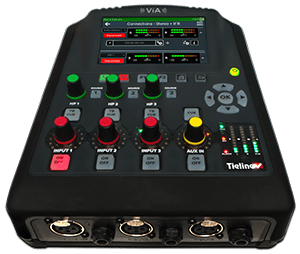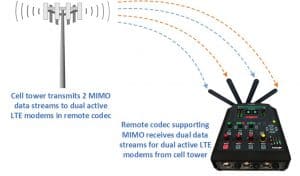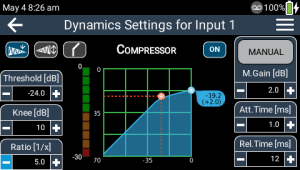Leading Edge Remote Technologies
By Jacob Daniluck, Technical Sales Specialist, Tieline
The latest remote codecs have evolved into ‘remote studios’ and offer significant benefits over codecs of old…
Before considering today’s leading edge remote technologies, let’s think back to not so long ago and how remote technologies have evolved from the 1990s until today. In the beginning, remote codecs were designed to:
- Eliminate the need for an expensive and cumbersome Remote Pickup Unit (RPU) with a Marti.
- Improve on poor quality narrowband 3kHz audio sent over standard copper POTS lines using the G.711 codec.
- Take advantage of available or privately installed ISDN lines to broadcast high quality remote audio.
Companies such as Tieline, Telos and Comrex broke new ground and offered technologies that supported sending high quality bidirectional audio between a studio and remote site, with vastly scaled down equipment requirements, when compared to the RPU model.
The Evolution of IP for Remote Broadcasts
Many people think using IP to broadcast and stream live is a relatively recent technology, however that’s far from the truth. The first remote broadcasts over IP were in the early 2000s, as cell-phone networks emerged offering GSM wireless data technologies. Suddenly, networks could broadcast remotes quickly at a moment’s notice from anywhere with cellular wireless data coverage. No RPUs or copper POTS and ISDN lines required.
Over the last decade or so, remote connectivity has been enhanced by the increased data capacity of 3G and 4G LTE networks, coupled with much wider cellular network coverage.
Today’s Remote Streaming Technologies

A decade or so ago the primary concern was how to get remote audio back to the studio reliably, whether that was over IP, ISDN or POTS. Now that the use of IP is more ubiquitous, especially in countries with advanced broadband infrastructure, network coverage is much easier to connect over reliably.
However, the nature of sending IP packets over the public internet means redundant IP backup streams are still essential, especially for mission critical broadcast infrastructure like studio-to-transmitter links (STLs). In addition, cellular wireless networks are only as good as:
- The coverage they provide.
- The speeds they support.
- The number of users sharing data.
- Whether QoS is available.
IP connections over the open internet are also vulnerable to variations in connection bandwidth and outages. Therefore, it is necessary to employ strategies to ensure redundancy in the event of IP packets being unable to reach their destination, or being delayed significantly.
Importance of Redundant Streaming
IP packets carry the IP addresses of their source and destination and can take completely different routes through different networks and switches, as routers determine the best route to take, or the most efficient node through which to reach the destination.
Redundant streaming is an IP packet replacement strategy whereby a codec can simultaneously send more than one identical data stream, to ensure that if IP packets are lost or arrive late, packets can be replaced from the other redundant stream. The decoding codec automatically reconstructs audio packets into a perfect single stream on a first packet arrived basis to ensure audio integrity. This technology allows switching back and forth, without loss of audio, from either data stream to ensure smooth playout of audio.
Additional redundancy is achieved by using IP links from two or more IP network providers to decrease the risk of a catastrophic loss of data. Some codecs support multiple redundant streams over multiple networks, which greatly increases the reliability of streaming over IP. In this situation packets are assembled on a first packet arrived basis from any of the redundant streams, as shown in the following image.

Vertical Integration of Outboard Equipment
There has also been a trend for broadcast manufacturers to vertically integrate complementary equipment into their products. In recent years codec manufacturers have focused on adding more advanced features into compact equipment, to eliminate the need for expensive and bulky outboard gear like mixers, limiters, compressors, equalizers, playback equipment and recorders. This is now available in a single remote codec – with no other equipment required.
This has obvious advantages, including:
- Portability: It’s much easier to ship equipment to remote sites.
- Less equipment is required: Broadcast setups are more streamlined and take less time.
- Podcasts can be produced onsite, and recorded files transferred over FTP, to improve production turnarounds.
In a sense it has been a natural progression to add more features into remote codecs. Engineers are often forced to ‘do more with less,’ sometimes because of scarce resources, and often just to streamline operations. By pushing the envelope of ‘what’s possible,’ codec manufacturers are providing new options and engineers are taking full advantage.
Significance of Opus and SIP for Interoperability
Opus as an encoder has grown in significance for broadcasters since it was first added to a professional broadcast audio codec in 2012. This is largely because it is an open source codec capable of high performance at both high and low bit-rates. It is also widely used in WebRTC applications and is one of the optional audio codecs mentioned in the EBU N/ACIP 3326 standard for Audio Contribution over IP, or SIP. This means Opus has been implemented by several codec manufacturers for SIP interoperability over IP.
SIP has grown in importance for broadcasters, and it does have its place from an interoperability perspective, but it also has it downside. Before using SIP over IP, it is useful to understand that:
- SIP requires both codecs to be configured with the same settings before connecting or the connection will fail.
- SIP connections are more complex to configure.
- Not all professional codec manufacturers are fully compliant with all requirements for interoperability.
- SIP does not support advanced software enhancements which deliver redundancy and rock-solid reliability over IP, e.g. failover connections, redundant streaming, IP bonding, or error concealment strategies.
So while SIP is important from an interoperability perspective, it lacks the ‘secret sauce’ you get when using two proprietary codecs from the same manufacturer. Codecs from the same manufacturer will generally connect more easily and offer redundant streaming, IP bonding, error concealment, and a host of other cool network configuration and monitoring features.
Cellular Remotes

In general, look for equipment that supports MIMO (Multiple Input Multiple Output) technology for 4G-LTE cellular connections when broadcasting. MIMO waves are slant polarised to support independent streams of data over the same cell tower frequency. MIMO is the standard downlink configuration for cellular modems over LTE networks, and this requires two separate external antennas for each modem for best performance. More antennas should provide better reception, which in turn will provide the best opportunity to achieve higher bandwidth connections than over single channel systems.
In time 5G cellular networks will deliver significantly higher bandwidth connections, however it may take quite some time to significantly roll out infrastructure. For those purchasing broadcast codecs today, most manufacturers should offer an upgrade path to support 5G network infrastructure as it is rolled out. Make sure you verify this before purchasing new equipment.
Remote Control: Final Piece in the Puzzle
Perhaps the last piece in the puzzle for engineers has been adding remote control to other innovations.
One of the down sides of a remote broadcast is that it is often very ‘remote’. In the past, engineers have often had to try and sort out connection issues at the remote broadcast site over the phone, or drive across town to get to the venue, which wasn’t always practical or even possible. Recent innovations in cloud-based server technology can provide engineers with complete remote control over all their codec assets.
How is this possible? Codec manufacturers have implemented Cloud Codec technology which allows remotely-connected devices to ‘reach out’ and ping cloud-based servers to identify themselves as soon as they connect to the internet – before they have dialed the studio. This allows an engineer at their home studio, or anywhere with an internet connection, to monitor the connection status of multiple remote devices simultaneously.

All units can be configured, connected and controlled remotely. It’s almost like being at every remote site. With this level of control available, late night rescue missions to get back on the air can be avoided more often than not.
For more information about Tieline codecs, or any of the features mentioned in “Leading Edge Remote Technologies”, visit http://www.tieline.com
Contact Tieline
- For USA, Canada & Latin America contact: sales@tieline.com
- For Australia and International: info@tieline.com
(Leading Edge Remote Technologies was first published in Radio Guide in the July/August edition 2019)





